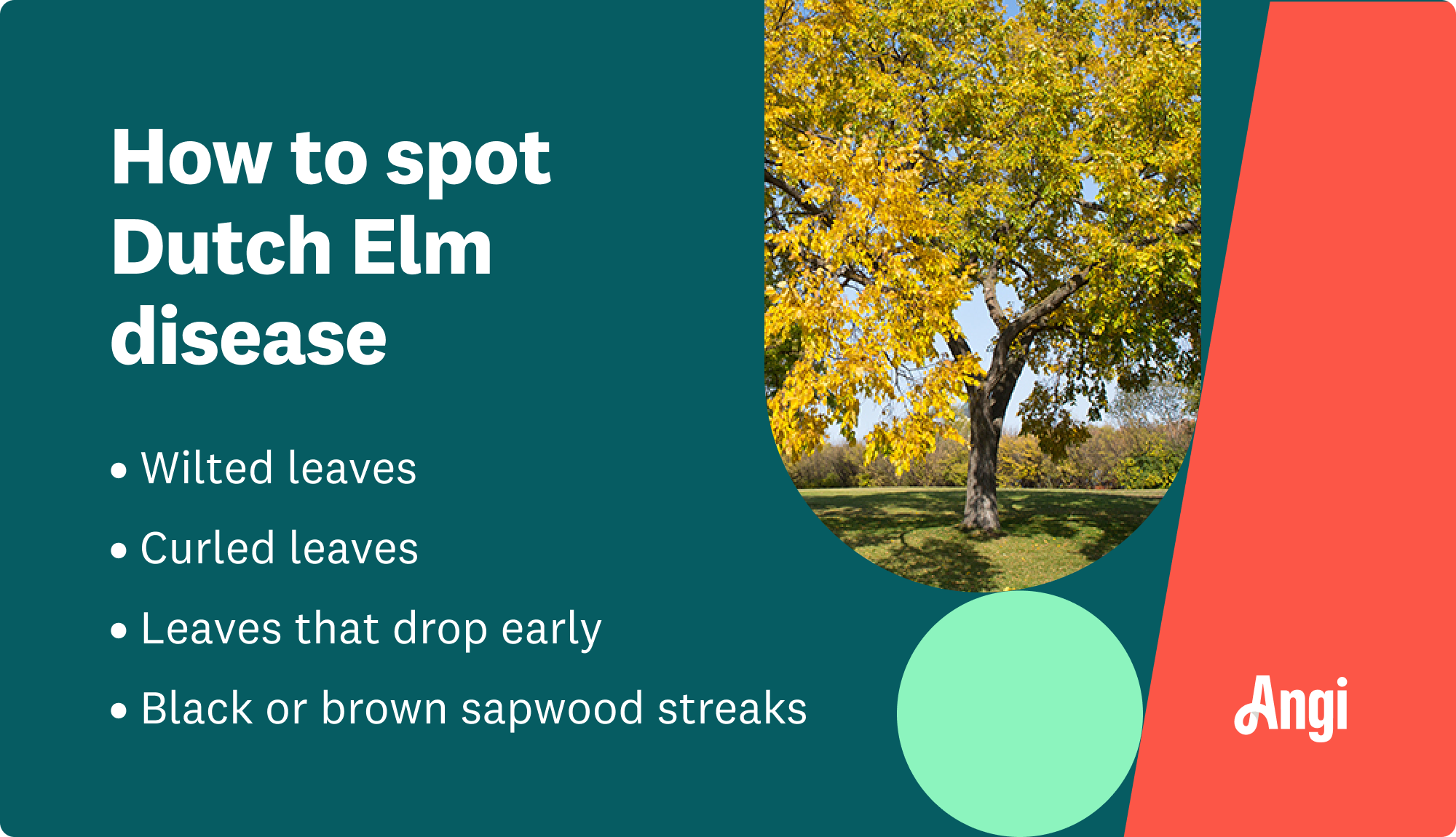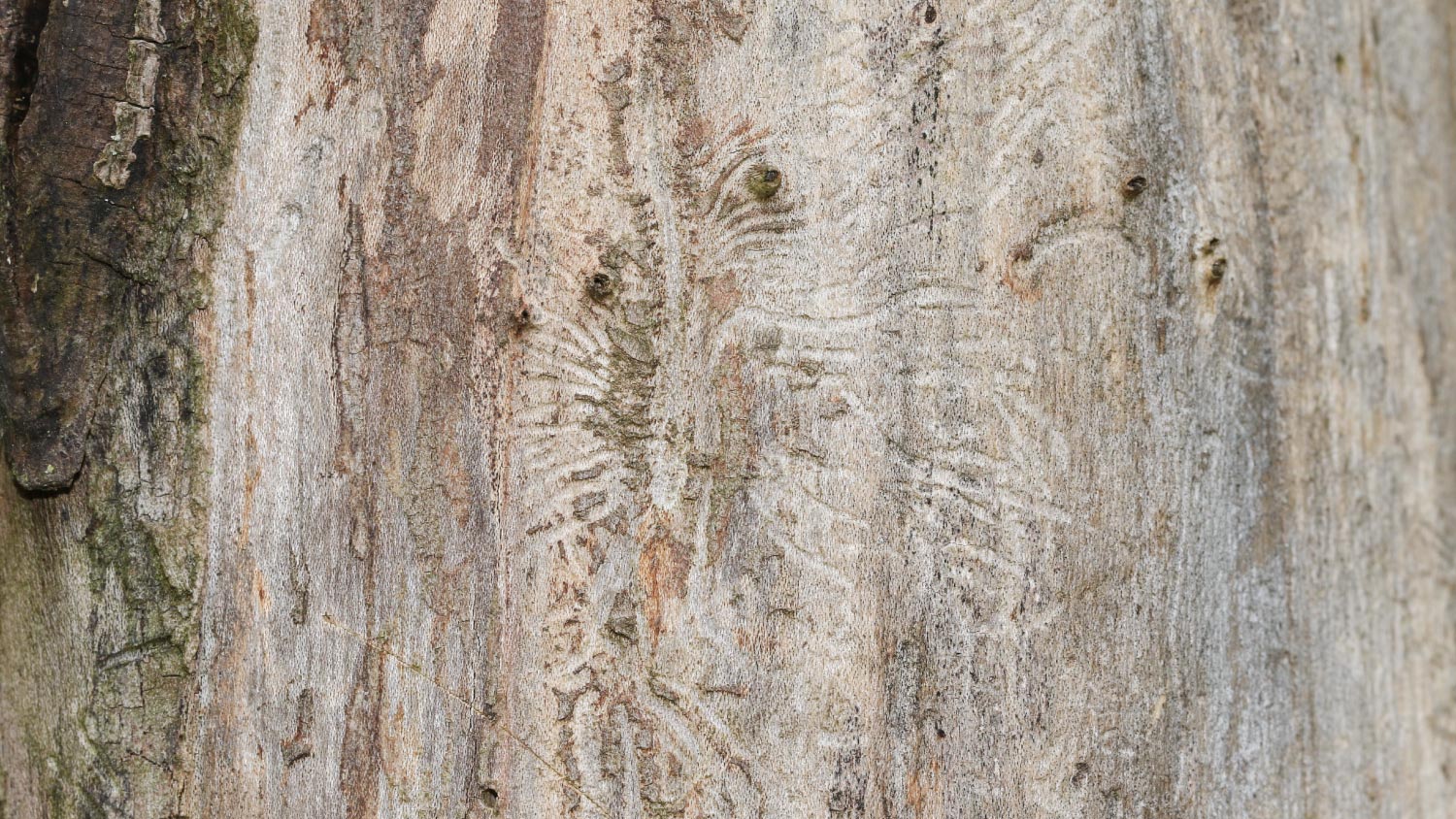Get transparent shrub removal cost info. Learn average prices, key cost factors, and tips to save on your next shrub removal project.
Dutch Elm Disease: Treatment, Symptoms, and More
Stop this fast-spreading tree disease in its tracks


Dutch elm disease has killed millions of elm trees throughout the United States, Europe, and New Zealand.
The disease spreads rapidly because trees can infect one another through their root system.
Signs of Dutch elm disease include yellowing, curling, or wilting leaves, or leaves that drop prematurely.
The treatment options for Dutch elm disease include pruning the infected branches, injecting a fungicide, spraying with pesticides, or removing the tree.
Dutch elm disease is a destructive tree illness that infects native elms, as well as some other tree species. Unfortunately, it’s a common issue, making it crucial for homeowners to learn Dutch elm disease treatment options.
This destructive fungal disease (carried by beetles) has wiped out millions of elm trees since the early 1900s. This guide will show you how to define Dutch elm disease, spot it in your yard, and treat the problem before it spreads.
Dutch Elm Disease Symptoms

Typically, symptoms of Dutch elm disease begin to emerge in late spring and eventually spread from individual branches to the entire tree. The process can take anywhere from months to years, but it will eventually kill your tree if left untreated. Lookout for the following signs:
Leaves that wilt before turning yellow or brown
Curled leaves
Leaves that prematurely drop
Brown or black streaking in sapwood (the soft layer of wood directly beneath the bark)
How to Check Your Tree for Elm Disease
You can check for Dutch elm disease by cutting a section of a dying branch and looking for discoloration. Some of these symptoms are very similar to other diseases, like elm phloem necrosis; therefore a formal diagnosis must be completed by a laboratory.
What to Do If You Suspect Your Tree Has Dutch Elm Disease
All elm species native to the United States are susceptible to Dutch elm disease, though Asiatic elms (like Chinese elm, Japanese elm, or Siberian elm) may have more resistance. If you suspect Dutch elm disease, call an arborist near you. They’ll confirm the diagnosis and help you with a treatment plan.
Dutch elm disease can be difficult to treat since it easily spreads. Unless you catch it early, you may need to remove significant portions of your tree, including some of the roots. An arborist will be able to save viable trees and protect all the elms in your yard. If you need assistance removing diseased branches from the tree, consider hiring a local tree maintenance professional to handle the task.
Dutch Elm Disease Treatments
Unfortunately, Dutch elm disease doesn’t have a simple cure. You can’t reverse the damage that’s done, but you can stop it from spreading. The most effective Dutch elm disease treatments get rid of the Elm Bark beetles that spread the disease and the fungus that attacks the tree’s vascular system. Here’s what you can do.
Prune the Diseased Branches
If you catch Dutch elm disease before it spreads to the main stem, you may be able to successfully prune the affected branches. Make sure you completely destroy any foliage you remove, since it can spread from tree to tree. This works best if you also use a fungicide.
Inject a Fungicide
Since Dutch elm disease is a vascular disease, injecting a fungicide into the roots can stop the fungal infection across your whole tree—but it will only work if your tree isn’t lethally damaged.
Use Pesticides
Pesticides can get rid of the beetle infestation that’s fueling the disease. This isn’t always the most effective method depending on which pesticides your arborist uses, but it can help.
Remove the Tree
Sometimes the only way to mitigate Dutch elm disease is to remove the affected tree, especially once the disease spreads thoroughly through the main stem. In this case, it’s best to—literally—cut your losses to prevent the disease from infecting the rest of your trees. You can plant a disease-resistant hybrid elm in its place.
Contact a Pro
If you suspect Dutch elm disease in your trees, contact a certified arborist in your area to diagnose it and provide treatment options. They’ll inspect the tree to determine if treatment is possible to keep the tree or if it needs removal. If treatment is an option, they can sever root grafts, remove or prune the affected branches and treat these areas with insecticides and fungicides every one to two years to prevent the disease’s recurrence. These professionals can also remove trees if they are past the point of recovery.
What Can I Do to Protect My Trees Against Dutch Elm Disease?
Dutch elm disease is a ravenous, fast-moving disease, but there are some things you can do to mitigate its spread:
Burn, debark, or bury dead or weak elm wood (including logs) to prevent beetles from laying eggs.
Break the root grafts of larger trees that are within 50 feet of each other. You’ll need to hire a local tree service for this task.
An annual spray of the insecticide methoxychlor over bark surfaces can kill many beetles before they leave behind spores.
Some fungicides such as thiabendazole hypophosphite and propiconazole can prevent the beetles from spreading the infection. Application is expensive, repeated seasonally, and needs to be injected into the tree by a professional arborist or a tree service company.
Plant hybrid elms that are resistant to Dutch elm disease, such as New Horizon, Accolade, Regal, and Frontier. Another option is the Chinese elm, Ulmus parviflora.
How Does Dutch Elm Disease Infect Trees?

The infection process starts with female bark beetles looking for weak elm wood (or logs or firewood) to lay their eggs in between the tree’s bark and wood. If the beetle is carrying Dutch elm disease, fungal spores spread throughout the tree area, and when young beetles emerge, they are covered in the fungal spores.
These young beetles feed on the leaves and twigs of healthy trees, spreading the spores to the tree. The spores then start new infections, and once the tree is weak, the beetles colonize it, repeating the cycle. Since the fungus enters the tree’s vascular system, the spores spread anywhere water goes, including the root system. In addition to beetle spread, the fungus can naturally spread via root grafts up to 50 feet away. When a tree is infected through its root system, it moves very quickly throughout the rest of the tree.
The homeowners guide to tree services
From average costs to expert advice, get all the answers you need to get your job done.
- •

The most significant factor in tree removal costs is the amount of debris. Read on to learn more about the average tree debris removal costs.

Tree inspections can ensure your trees stay healthy and safe, preventing costly damage. Learn how much tree inspections cost and what can affect the price.

Tree stumps can be unsightly trip hazards, but they can also have a new life. Learn how to hollow out a tree stump to repurpose it into a planter.

If you’ve hired a tree service to trim your trees or remove them, you’ll have to decide whether to tip the pros afterward. Learn more about your options.

While palm trees don’t need much maintenance, they occasionally require trimming to keep them healthy. Learn how to trim a palm tree.

